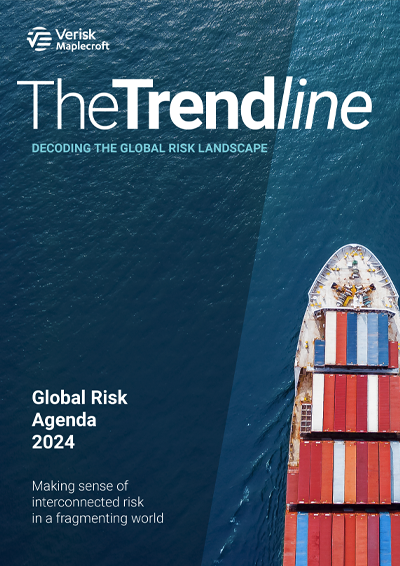Inflection Points: Risks to watch in 2024
The Trendline
by Jess Middleton,
Rising geopolitical tensions, prolonged economic instability and the wider impacts of the conflicts in Ukraine and Gaza were just a few of the risks that businesses had to contend with in 2023.
Our data shows that the fallout from these interconnected issues has contributed to growing instability in the global risk landscape. Indeed, risks increased at a global level across 67 of the 123 political, human rights and economic issues tracked by our data over the past year, compared to 49 that saw an improvement.
It is against this backdrop that companies will have to navigate the major challenges of 2024, from the outcome of a host of consequential elections to the reorientation of supply chains and the impacts of the escalating climate crisis.
This article unpacks the latest findings from our Global Risk Data, highlighting the key trends and signals that will underpin the risk environment over the next 12 months.
Packed election calendar highlights global democratic backsliding
Countries home to more than 4bn people, or around half the world’s population, are set to head to the polls in 2024. This includes the US, India and Indonesia, the world’s three largest democracies.
This democracy super-cycle will shine a light on the strength of governance systems around the globe, as well as their vulnerabilities. Indeed, of the 64 countries holding elections (excluding the EU parliamentary elections), 22 fall within the two highest risk categories of our Democratic Governance Index (DGI), which measures factors such as threats to electoral processes, civil and political rights and the independence of institutions.
At the same time, our data shows that the quality of global democracy has been waning over the past five years. Since 2019, 115 of the 198 countries assessed by the index have seen an increase in risk. This includes the US, which while retaining its low risk categorisation dropped 29 places in the ranking to 143rd highest risk. Brazil (ranked 102nd, down from 115th) and Turkey (ranked 41st, down from 57th) are also undergoing this negative trend.
Some 72 countries now fall within the two highest risk categories of the index, the largest number since the DGI launched in its current form back in 2016.
Figure 1: Threats to democratic governance have increased in most countries
“Deteriorating democratic governance is a material concern for corporates, investors and insurers as it can trigger wider political risks,” says Senior MENA Analyst Hamish Kinnear. “In countries undergoing democratic backsliding, the rule of law typically suffers as checks on executive power are weakened. Companies could also face reputational risks if their investments are tied to human rights abuses in a country where there is growing authoritarianism.”
Conflict a global concern
The outcome of these elections could have a significant impact on the global response to the ongoing conflicts in Ukraine and Israel-Gaza. Unsurprisingly, both Israel and Palestine saw an increase in risk on our Conflict Intensity Index over the past year. Israel now ranks as 4th highest risk on the index, while Palestine is ranked highest risk globally.
But looking beyond the Middle East shows that conflict is a growing issue the world over, with 17 countries registering an increase in risk on the index over the past 12 months.
The sharpest increase was registered by Sudan, which slipped from 30th to 15th highest risk as a result of its ongoing civil war. Elsewhere in Africa, the jihadist insurgency in Burkina Faso, part of a broader trend seen across the Sahel, has seen the country move to 2nd highest risk.
The latest edition of the index shows 34 countries rated as high or very high risk, up from 30 at the start of 2021. This diverse group includes countries as varied as Armenia (ranked 10th highest risk), Colombia (22nd) and Thailand (31st).
Figure 2: Conflict risks present in all regions
“An uptick in armed conflict across the globe poses myriad challenges to multinational businesses,” says our Head of EMEA Research Hugo Brennan. “From increased shipping and insurance costs associated with Houthi attacks on shipping in the Red Sea through to ensuring company personnel and assets are sufficiently protected in volatile jurisdictions.”
Human rights complicating supply chain diversification
Faced with mounting geopolitical tensions, companies are increasingly looking to ‘nearshore’ or ‘friendshore’ their supply chains into alternative markets.
Emerging economies such as Mexico, Vietnam and India look set to be the main beneficiaries of this new era of supply chain diversification. But an expanding raft of regulations governing human rights in supply chains means that shifting to new markets could see companies swap one set of risks for another.
Indeed, looking at the performance of 10 key sourcing locations across a host of human rights issues shows that companies face a high, and in many instances rising, risk of exposure to human rights breaches in these countries.
Figure 3: Human rights risks worsening in sourcing markets
“Supply chain due diligence procedures are becoming increasingly mandatory, demanding and consequential,” notes our Director of Human Rights Dr James Sinclair. “While nearshoring can be a superficially attractive strategy for companies looking to de-risk their supply chains, stalling progress on human rights means there is rarely a ‘silver bullet’.”
Record temperatures underscore need to prepare for future climate impacts
Last year was the hottest in recorded history. The average global temperature hit 1.48C above pre-industrial levels, and scientists suggest that the key warming threshold of 1.5C could be surpassed for the first time in 2024.
Crossing that benchmark will place greater scrutiny on businesses in high-emitting sectors, leaving them vulnerable to reputational and financial damage if their operations are tied to climate change.
Indeed, 143 of the 198 countries tracked by our Climate Litigation Index - which assesses the likelihood of lawsuits being pursued against companies in relation to climate change – saw an increase in risk over the past year, with those operating in developed economies facing the highest risk of legal action.
At the same time, businesses will increasingly need to factor climate impacts into their resilience planning. One key area of concern will be major commercial centres, where rising temperatures are magnified due to the trapping of heat by buildings, pollution and infrastructure.
Data from our Extreme High Temperatures dataset, which measures the frequency with which air temperatures are set to exceed 35C, highlights the extent of the problem. Some 60 of the 770 world cities with a population over a million are rated high or very high risk on the index in current climate conditions.
That figure could grow to 136 by mid-century according to our data covering a scenario in which global CO2 emissions do not start to decline until 2045, affecting cities currently home to 473m people and a host of major urban hubs such as Bangkok, Mumbai and Dallas.
Figure 4: Number of cities exposed to extreme heat to surge by 2050
“Organisations need to understand how hotter cities impact them, whether that’s through higher cooling costs, failing infrastructure, health issues for workers, or even increasing scarcity of water and energy,” says our Head of Climate and Resilience Will Nichols. “Only by identifying future threats can organisations build the resilience they need to be successful in a rapidly changing climate.”
Data vital for building resilience to evolving risks
The issues highlighted above are just a few examples of the risks that businesses will need to monitor throughout 2024. Those that embed cutting-edge data and analytics will stand the best chance of anticipating where shifts in the global risk landscape could impact the resilience of their operations, supply chains and investments.


